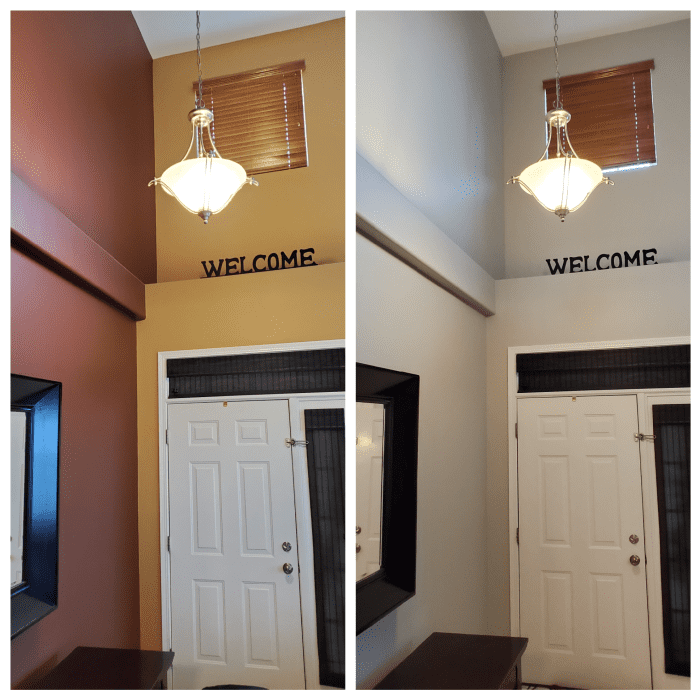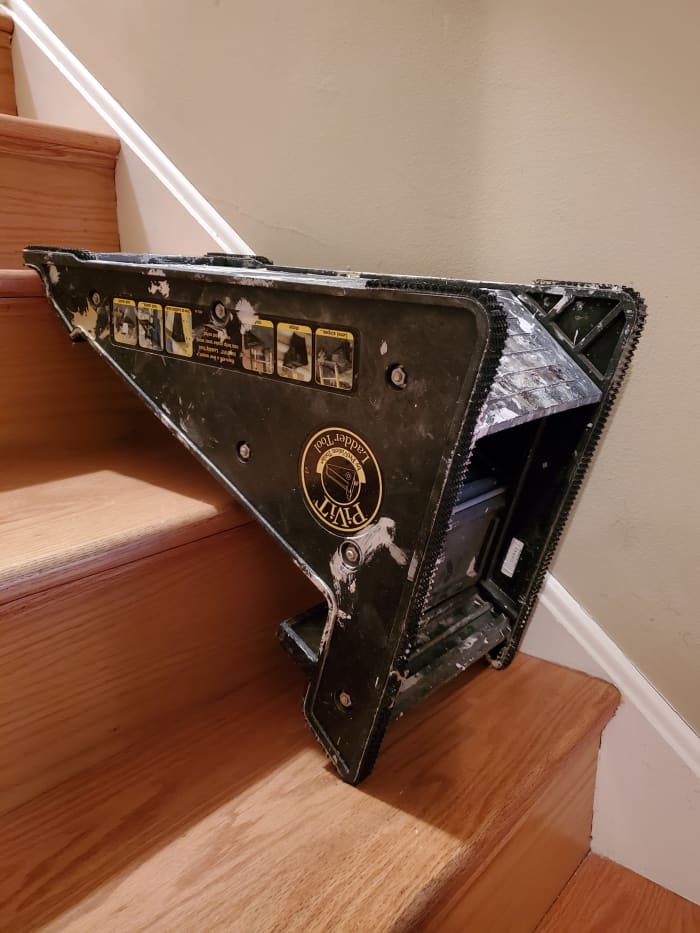Diy Easy and Quick Way to Make a Scaffolding for Inside a Home to Paint High on Walls
Matt is a professional painter who owns and operates his own painting business, specializing in interior and exterior house painting.

Foyer walls I painted with the color Repose Gray from Sherwin Williams.
Painting High Walls Without Scaffolding
Maybe you want to paint the two story walls in your foyer, but you're scared of the extreme height, or you simply have no idea how to tackle the project. Although painting a foyer with high walls is certainly more challenging than painting a typical room with eight foot walls, it is actually a lot easier than you think.
Most people resort to scaffolding and assume it's the only way to paint high walls, but that isn't the case, unless you need to repair drywall on the ceiling where a ladder can't reach. If you don't have any ceiling repairs to do, you don't have to use scaffolding to get the painting done. I'll show you exactly how I paint a foyer and the tools I use.
Supplies for this project:
- Drop cloths
- Bucket hook
- Paint tray/bucket
- 3-inch paint brush
- 16 to 23-foot extension pole
- Painter's tape
- 9-inch paint roller and frame
- 20 to 24-foot extension ladder (alternative: extendable brush)
- Ladder leveler (for walls over stairs)
- Premium latex paint

My extendable paint brush.
Step 1: Cut In the Foyer's Ceiling Corners
The best way to cut-in ceiling corners in a two story foyer is with an extension ladder, not scaffolding. You need to know the height of your foyer in order to choose the right ladder size. I use an aluminum extension ladder that extends to twenty four feet. This ladder length has worked perfectly for all of the two level foyers I've painted.
To cut-in foyer walls that extend up a stairway, I'll either use my 24-foot ladder or my shorter 16-foot ladder with my Pivit ladder leveler underneath on the stairs. Scared of heights? You can cut-in the walls with an extendable brush on a pole too.
Use a bucket/pail hook: Bucket hooks are cheap and absolutely essential for cutting-in walls from extension ladders. These metal hooks allow you to hang your paint can from the rung of the ladder. I've used the same bucket hooks for many years and never had one slip off the ladder rung or break.
Use a leveler on stairs: Foyer walls extending up a stairway are easy to paint with the right tools. There are three different ways to paint foyer walls going up a stairway. You can use an extension ladder with adjustable legs on the bottom, a ladder leveling tool, or an extendable paint brush on a painting extension pole. Using a brush extender on a pole eliminates ladders, but keep in mind that cutting-in straight lines that way is more challenging.
Scroll to Continue
Read More From Dengarden
For ladder leveling, only use a tool designed for that purpose. I've used the Pivit ladder leveler for several years to paint over stairs indoors. This is an awesome tool if your extension ladder doesn't have adjustable legs on the bottom. The Pivit is my favorite multi-tool for stairs and painting on rooftops.
Tape off the baseboard. The baseboard and molding around the front door have to be taped off before you can start cutting-in. Most people use blue painter's tape, but I recommend spending a few extra dollars for a roll of green Frogtape instead. The tape does a better job at preventing paint from leaking underneath. The tape also sticks better than blue tape.
Use a quality paint brush. I'm a big fan of the Purdy Clear Cut brush in the 3-inch size. I like the Sprig style with the wider handle. I use the Clear Cut brush only for cutting-in wall and ceiling corners. The bristles hold a good amount of paint and cut perfectly straight lines better than other brushes I've used. I'm able to use the same brush for several projects before I need to buy a new one. Don't use a cheap paint brush. The brush won't perform well or last as long.
Cut-in two coats. The last thing you want is to finish your project and realize you should have applied another coat of paint because the color underneath is showing through. With premium paint, most colors cover in two coats unless the new color is much lighter than the old color.
With an extension ladder, or an extendable brush, cut-in the upper half of the walls two coats, working in one direction all the way around the foyer. Cut-in the lower half of the walls around the front door frame and molding with a step ladder.

My Pivit leveler I use for painting foyer walls over stairs.
Step 2: Roll the Walls With an Extension Pole
A paint roller extension pole is a must-have for painting two story walls, but I recommend using two poles. I roll the upper half of high walls with a 16-foot pole and the lower half with an 8-foot pole. The shorter pole is a lot easier to work with in tight spaces. The only purpose of the longer pole is to roll the high area that cannot be reached with a shorter pole.
I own a 16-foot extension pole from Purdy and use it for painting high walls and ceilings. The 16-foot length is perfect for most of the big foyers and great rooms I paint. It's perfect for painting high ceilings and cutting-in around light fixtures that you cannot reach from a ladder. The pole uses a button lock instead of a twist lock, which I like better. Determine the height of your foyer because you might need a longer pole than the one I use.
Paint the ceiling first. Don't paint the ceiling after the walls otherwise the finished walls would have to be protected with plastic. Cutting-in ceiling paint to a wall is also more difficult than cutting-in wall paint to a ceiling. If the ceiling colors are similar, you can usually get away with only having to paint one coat. The fastest way to paint a foyer ceiling is to fill the corners with an extendable paint brush and roll it with an 18-inch paint roller. Using a ladder to paint a ceiling is unnecessary. You can paint any ceiling with only a roller and a brush on a pole.
Roll the walls two coats. Once the walls are cut-in, roll the walls evenly with two coats of paint, working in one direction all the way around the foyer to where you started. Roll the upper half of the walls first, working in sections, but always in one direction from corner to corner. Keep a wet edge of paint. I like to roll the upper half of the wall in about four foot wide sections, swap my long pole out for the shorter pole, and then roll the bottom half of the wall. This helps prevent roller marks because you're rolling into the wet paint on the upper half of the wall. Don't roll half the wall first and the other half last. Use a lint-free roller 9 to 18-inches in length.
This content is accurate and true to the best of the author's knowledge and is not meant to substitute for formal and individualized advice from a qualified professional.
© 2021 Matt G.
Source: https://dengarden.com/home-improvement/Tips-for-Painting-a-Foyer-without-Scaffolding
0 Response to "Diy Easy and Quick Way to Make a Scaffolding for Inside a Home to Paint High on Walls"
Post a Comment